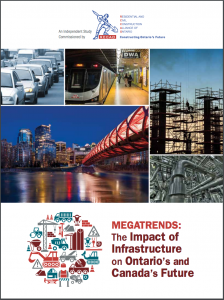
Megatrends will influence how $176B in infrastructure will be spent in Ontario: report
By On-Site Magazine
Construction Infrastructure infrastructure Ontario report The Wynne government has pledged $130 billion on infrastructure investment over 10 years, while the Trudeau government may be earmarking about $46 billion for Ontario. But what factors will influence how effective infrastructure decisions are made?
The Wynne government has pledged $130 billion on infrastructure investment over 10 years, while the Trudeau government may be earmarking about $46 billion for Ontario. But what factors will influence how effective infrastructure decisions are made?
An updated independent report by former Ontario Deputy Minister Michael Fenn attempts to answer this question by focusing on six megatrends – major trends or movements – shaping the future of infrastructure. The “Big Six” are:
- Technological.
- Urbanization, globalization and connectivity.
- Social and demographic.
- Economic and workforce.
- Environmental and energy.
- Political and fiscal.
“These trends will shape our future, so our decisions should anticipate and respond to them,” says Fenn, author of Megatrends: The Impact of Infrastructure on Ontario’s and Canada’s Future. “Big infrastructure choices are expensive and long-lived. Good decisions will serve our children and grandchildren, but imprudent decisions can burden us for several generations. Local responses to global forces – climate change and migration – must overcome short-term political and business goals to enable success in Ontario and Canada.”
Commissioned by the Residential and Civil Construction Alliance of Ontario (RCCAO), Fenn’s report identifies 11 impacts such as the convergence of functions, customization and expanded consumer choice in public services. As a result, there will be:
- Increased automation and sharing of personal vehicles, and the advent of high-speed trains and more lake-based shipping will regenerate the economies of our cities. In turn, this will alter radically Ontario’s land-use and transportation plans, and disrupt traditional assumptions about commuting patterns, public transit and toll-free expressways.
- Lighter and more adaptable infrastructure, with high-performing materials and shorter life-cycles.
- Fewer bricks-and-mortar hospitals and school campuses; more community-based, technologically enabled alternatives.
- Greater connectivity, including Nano-sensors and embedded RFID chips linked to the Internet of Things.
Andy Manahan, RCCAO executive director, adds: “Mr. Fenn has provided excellent advice and reasons why we must be more forward-thinking in our future infrastructure choices.”




